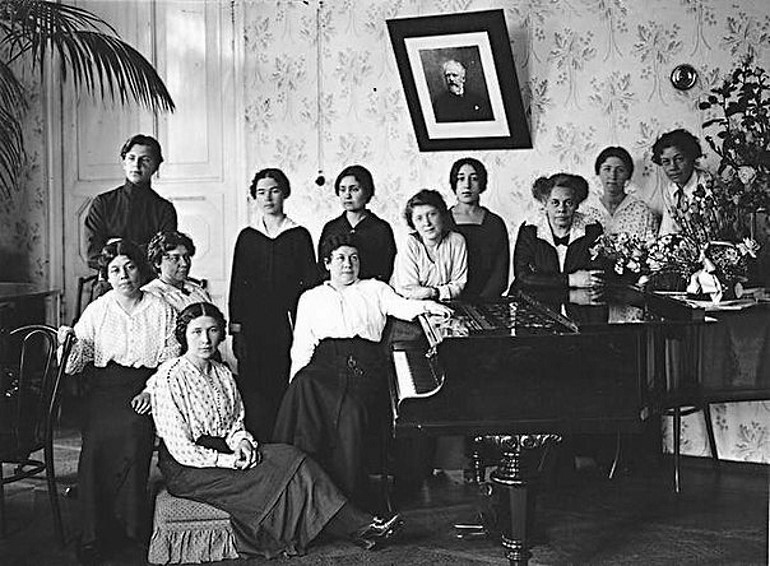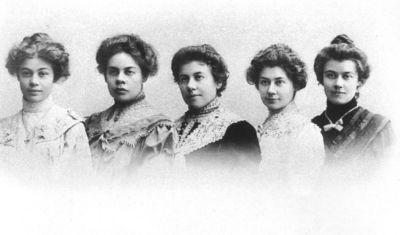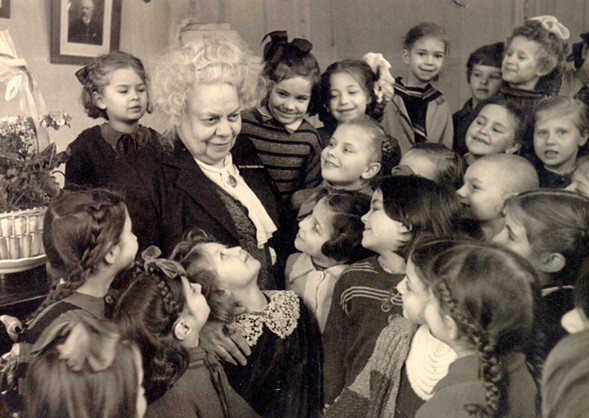
“Is that you, Mark?” shouted Elena Fabianovna from the back room, when my grandpa came into the anteroom. Gnessina recognized her students by the sound of their steps. Any history – of an organization, company or country – is built on people who come out with their special cause and breathe life into it. Such were the sisters Elena, Eugenia and Maria who were the beginning of the history of famous Gnessinka – one of the best musical schools in Russia that has turned 120.
The Gnessin sisters were born in Rostov on Don. Their father Fabian O. Gnessin was an official rabbi and their mother Bella was a promising singer and pianist, a disciple of Stanislav Monyushko. After she gave birth to 12 kids, she definitely could not make any professional career, but she was perseverant in giving her children musical and cultural education. Seven of them became musicians.
The Silver Age begins
In spite of the fact that there was a strict quota for Jewish students in pre-revolutionary Russia, two older sisters Eugenia and Elena did not have great problems entering the Moscow Conservatory. Moreover, Eugenia was invited to her class by future principal of the Conservatory Vasily I. Safonov. Among her teachers were A.S. Arensky and S.I. Taneev. Elena studied with Ferruccio Busoni, pianist and composer, well-known for his editions and piano transcriptions of Bach and Liszt. She was so successful that the famed Italian invited her to join him on a tour abroad, but the girl declined that proposal because she was too young.
Later the younger sisters Maria, Elizaveta and Olga joined their older sisters. They studied in the most illustrious period for the Moscow Conservatory, when it was studded with true stars. The girls found themselves in the center of the Moscow music life: among their student mates were Skryabin and Rakhmaninov and in its corridors one could come across Taneev, Arensky, Lyadov and even Tchaikovsky. The young musicians were actually surrounded by prominent workers of art from the nascent Silver Age, who were friends of their mentors – there could hardly be a more fruitful environment and motivation for the development of their talent.
Small family business

Suddenly sad news came about the death of their father Fabian. Not only was their family struck with grief; this meant there was nobody to pay the tuition fees for them. Perhaps it was at that time that Elena came up with the idea to start teaching and to open an educational institution, even if small. Thus on February 15, 1895 a new music school was founded by three Gnessin sisters: Elena, Eugenia and Maria. Until 1962 the school had been accommodated in the well-known Khomyakov House at Arbat.
The older sister Elena was the school’s principal and art director. She taught the piano playing methodology and authored several famous textbooks, including the well-known Piano Alphabet. Eugenia taught piano and theory of music and was also the school’s artistic director. Not only did the sisters teach special piano and fiddle classes; they also taught music theory, led choirs and ensembles. The latter disciplines were given great importance – this was how the Gnessin School was different from other private educational establishments of Moscow. Furthermore, the Gnessin School was the first musical institution in Moscow where children’s school choir was created.
Later on two junior sisters joined three older sisters, so that five Gnessin sisters were teaching within the walls of their school, where both kids and adults were studying at that time. The tuition principles were pivoted on the Conservatory school, but, to be sure, each of the sisters brought in her own individuality.
On the Conservatory level
The school’s popularity and authority grew quickly. Five Gnessin sisters, enthusiasts of their cause, who devoted their entire life to musical pedagogy, had lived half a century in the house where their brainchild was accommodated. The atmosphere of their hospitable house invariably attracted both the current and former students, who already became well-known musicians, and their colleagues. Many prominent musicians held the Gnessin School in highest esteem and some of them started teaching there like, for example, composers R.M. Glier and A.T. Grechaninov as well as pianist E.A. Bekman-Shcherbina. Soon the school of the young sisters were so popular that students who were getting ready for entering the Moscow, St. Petersburg and even Leipzig Conservatory sought enrollment there.

Another amazing fact: not only was Elena Gnessina the school founder; she had been the irreplaceable chief administrator of the future Gnessin schools and institutes during the long 72 years! She certainly possessed inexhaustible willpower and energy, or the educational institution would not weather post-revolutionary or wartime storms.
In 1919 the school received the status of a state-run establishment and next year it was divided into children’s school and college with unified administration. In 1923 Mikhail Gnessin, a brother of the sisters Gnessin, who was a talented composer and pianist and graduated from Rimsky-Korsakov Conservatory in St. Petersburg, started the music theory and composition department. The level of teaching was steadily going up and now, to enter the Gnessin School, one had to pass stiff competition, and those who wanted to finish the course had to work hard. The nation was in need of working hands, so the musician’s career was a hard choice and, unless the students were up to the mark they could be expelled and replaced by more talented and hardworking fellows.
Four in one
At first they trained musicians for further education at the Conservatory in Gnessin School, but then the idea of establishing the second music university became relevant and in 1944 the government decreed the organization of Gnessin State Musical-Pedagogical Institute. Compared to the Conservatory’s course, at GMPI they placed a greater emphasis on pedagogical specialization. In 1946, a specialized secondary school was opened under the Institute. Thus a complex of four educational institutions was established: institute, college, specialized school and seven-grade school led by Elena Gnessina.
Outstanding musicians of their age worked at Gnessinka, including G.G. Neygauz, M.V. Yudina, L.N. Oborin, T.D. Gutman, K.A. Erdeli, V.D. Konen, N.A. Garbuzov, A.N. Yurovsky and many others. Here, for the first time in the history of higher education, a faculty of folk instruments was established. Like mushrooms after the rain, new chairs lacking at other musical institutions sprang up, and a number of student teams were formed, like the symphony, Russian, folk and chamber orchestras, academic choir and opera studio. In the 1950s the chairs of opera singing and chamber ensemble were created and in the 1960s – the chairs of orchestra conducting, pedagogy and methodology. In 1966, for the first time, a department of folk choir conductors was opened. In 1970-1980s the departments of solo folk singing, variety art and audio engineering were formed.
Thus Gnessinka deservedly came to occupy a special niche in the Russian culture, having aligned with the Moscow and Leningrad conservatories. Now as Gnessinka has this high status, each jubilee date becomes a unique event in the history of Russian musical education. The Gnessin traditions are still treasured nowadays. Teachers remember the sound of their students’ steps and the students tell the entire world through their music about the glorious musical history of their alma mater.
Anna Genova










